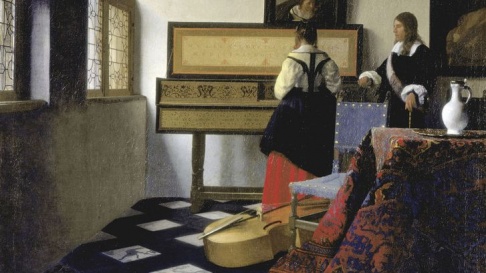Johannes Vermeer is among the Netherland’s most renowned painters. His work remains a source of intrigue because of his uncanny ability to paint in a way reminiscent of photography. A new documentary may shed some light on the matter.
There is little known about Vermeer’s artistic teachers and influencers, making his unique style difficult to trace. Between 2008 and 2013 Tim Jenison, a Texan inventor and graphic cinematography specialist, tested his theory about what Vermeer may have used to create his famous paintings. Titled Tim’s Vermeer, the experiment was captured on film and released as a documentary in early 2014.
Jenison was intrigued by Vermeer’s ability to capture light “in a way that the human retina is not capable of registering” according to the inventor. He built an exact replica of the room seen in Vermeer’s painting The Music Lesson, designed an optical machine and proceeded to paint. Rather than trying to recreate the painting, Jenison aimed to unlock the secret to the possible science behind Vermeer’s work. His experiment has been met with mixed reviews.
Some see the experiment has trying to explain away the talent of one of the world’s most infamous painters. Others see it as a step towards unlocking the secrets behind Vermeer. Herman Weyers, Director of the Vermeer Centrum Delft, indicates that there are many people interested in how Vermeer painted so photographically. “We have at least one or two people a year who come to us with a new theory on how Vermeer painted,” notes Weyers proudly. “It isn’t a new idea for us that Vermeer used an optical device when he painted,” he adds.
Vermeer was friends with Antonie van Leeuwenhoek who is famous for his work in designing the microscope. Weyers notes that there has been speculation that van Leeuwenhoek may have helped Vermeer design an optical device. “They were close friends so it makes sense that van Leeuwenhoek would help Vermeer design an optical device,” shares Weyers. “But without any documentation we can never know for sure. We need people like this inventor [Jenison] to keep trying to find the answer.”
Whilst Jenison did not contact the Vermeer Centrum as part of his documentary, Weyers is very interested to see the device created. “One day we would like this centre [Vermeer Centrum Delft] to be a place of knowledge sharing; where people can exchange their ideas about Vermeer and how he may have painted,” says Weyers. “I hope that one day we find the answer to how Vermeer painted so photographically.”



Comments are closed.